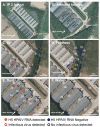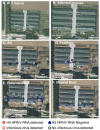The Role of Airborne Particles in the Epidemiology of Clade 2.3.4.4b H5N1 High Pathogenicity Avian Influenza Virus in Commercial Poultry Production Units
- PMID: 37112981
- PMCID: PMC10142477
- DOI: 10.3390/v15041002
The Role of Airborne Particles in the Epidemiology of Clade 2.3.4.4b H5N1 High Pathogenicity Avian Influenza Virus in Commercial Poultry Production Units
Abstract
Since October 2021, Europe has experienced the largest avian influenza virus (AIV) epizootic, caused by clade 2.3.4.4b H5N1 high pathogenicity AIV (HPAIV), with over 284 poultry infected premises (IPs) and 2480 dead H5N1-positive wild birds detected in Great Britain alone. Many IPs have presented as geographical clusters, raising questions about the lateral spread between premises by airborne particles. Airborne transmission over short distances has been observed for some AIV strains. However, the risk of airborne spread of this strain remains to be elucidated. We conducted extensive sampling from IPs where clade 2.3.4.4b H5N1 HPAIVs were confirmed during the 2022/23 epizootic, each representing a major poultry species (ducks, turkeys, and chickens). A range of environmental samples were collected inside and outside houses, including deposited dust, feathers, and other potential fomites. Viral RNA (vRNA) and infectious viruses were detected in air samples collected from inside and outside but in close proximity to infected houses, with vRNA alone being detected at greater distances (≤10 m) outside. Some dust samples collected outside of the affected houses contained infectious viruses, while feathers from the affected houses, located up to 80 m away, only contained vRNA. Together, these data suggest that airborne particles harboring infectious HPAIV can be translocated short distances (<10 m) through the air, while macroscopic particles containing vRNA might travel further (≤80 m). Therefore, the potential for airborne transmission of clade 2.3.4.4b H5N1 HPAIV between premises is considered low. Other factors, including indirect contact with wild birds and the efficiency of biosecurity, represent greater importance in disease incursion.
Keywords: H5N1; aerosol; airborne; avian; avian influenza virus; droplet; dust; transmission.
Conflict of interest statement
The authors declare no conflict of interest.
Figures



Similar articles
-
Clade 2.3.4.4b H5N1 high pathogenicity avian influenza virus (HPAIV) from the 2021/22 epizootic is highly duck adapted and poorly adapted to chickens.J Gen Virol. 2023 May;104(5). doi: 10.1099/jgv.0.001852. J Gen Virol. 2023. PMID: 37167079
-
Genetic Characterization and Pathogenesis of H5N1 High Pathogenicity Avian Influenza Virus Isolated in South Korea during 2021-2022.Viruses. 2023 Jun 20;15(6):1403. doi: 10.3390/v15061403. Viruses. 2023. PMID: 37376703 Free PMC article.
-
Pathogenicity in Chickens and Turkeys of a 2021 United States H5N1 Highly Pathogenic Avian Influenza Clade 2.3.4.4b Wild Bird Virus Compared to Two Previous H5N8 Clade 2.3.4.4 Viruses.Viruses. 2023 Nov 18;15(11):2273. doi: 10.3390/v15112273. Viruses. 2023. PMID: 38005949 Free PMC article.
-
The genetics of highly pathogenic avian influenza viruses of subtype H5 in Germany, 2006-2020.Transbound Emerg Dis. 2021 May;68(3):1136-1150. doi: 10.1111/tbed.13843. Epub 2020 Sep 29. Transbound Emerg Dis. 2021. PMID: 32964686 Review.
-
Iceland as Stepping Stone for Spread of Highly Pathogenic Avian Influenza Virus between Europe and North America.Emerg Infect Dis. 2022 Dec;28(12):2383-2388. doi: 10.3201/eid2812.221086. Epub 2022 Oct 19. Emerg Infect Dis. 2022. PMID: 36261139 Free PMC article. Review.
Cited by
-
Control technologies to prevent aerosol-based disease transmission in animal agriculture production settings: a review of established and emerging approaches.Front Vet Sci. 2023 Nov 14;10:1291312. doi: 10.3389/fvets.2023.1291312. eCollection 2023. Front Vet Sci. 2023. PMID: 38033641 Free PMC article. Review.
-
Preventive, safety and control measures against Avian Influenza A(H5N1) in occupationally exposed groups: A scoping review.One Health. 2024 Jun 17;19:100766. doi: 10.1016/j.onehlt.2024.100766. eCollection 2024 Dec. One Health. 2024. PMID: 39021558 Free PMC article.
-
Rapid mortality in captive bush dogs (Speothos venaticus) caused by influenza A of avian origin (H5N1) at a wildlife collection in the United Kingdom.Emerg Microbes Infect. 2024 Dec;13(1):2361792. doi: 10.1080/22221751.2024.2361792. Epub 2024 Jun 5. Emerg Microbes Infect. 2024. PMID: 38828793 Free PMC article.
-
Viral shedding and environmental dispersion of two clade 2.3.4.4b H5 high pathogenicity avian influenza viruses in experimentally infected mule ducks: implications for environmental sampling.Vet Res. 2024 Aug 12;55(1):100. doi: 10.1186/s13567-024-01357-z. Vet Res. 2024. PMID: 39135123 Free PMC article.
-
Applying Field and Genomic Epidemiology Methods to Investigate Transmission Networks of Highly Pathogenic Avian Influenza A (H5N1) in Domestic Poultry in British Columbia, Canada (2022-2023).Transbound Emerg Dis. 2025 Jul 15;2025:4099285. doi: 10.1155/tbed/4099285. eCollection 2025. Transbound Emerg Dis. 2025. PMID: 40697881 Free PMC article.
References
-
- Adlhoch C., Brouwer A., Kuiken T., Mulatti P., Smietanka K., Staubach C., Guajardo I.M., Verdonck F., Amato L., Baldinelli F. Avian influenza overview February–May 2018. EFSA J. 2018;16:e05358. - PubMed
Publication types
MeSH terms
Substances
Grants and funding
LinkOut - more resources
Full Text Sources
Medical

